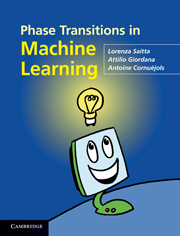Book contents
- Frontmatter
- Contents
- Preface
- Acknowledgments
- Notation
- 1 Introduction
- 2 Statistical physics and phase transitions
- 3 The satisfiability problem
- 4 Constraint satisfaction problems
- 5 Machine learning
- 6 Searching the hypothesis space
- 7 Statistical physics and machine learning
- 8 Learning, SAT, and CSP
- 9 Phase transition in FOL covering test
- 10 Phase transitions and relational learning
- 11 Phase transitions in grammatical inference
- 12 Phase transitions in complex systems
- 13 Phase transitions in natural systems
- 14 Discussion and open issues
- Appendix A Phase transitions detected in two real cases
- Appendix B An intriguing idea
- References
- Index
9 - Phase transition in FOL covering test
Published online by Cambridge University Press: 05 August 2012
- Frontmatter
- Contents
- Preface
- Acknowledgments
- Notation
- 1 Introduction
- 2 Statistical physics and phase transitions
- 3 The satisfiability problem
- 4 Constraint satisfaction problems
- 5 Machine learning
- 6 Searching the hypothesis space
- 7 Statistical physics and machine learning
- 8 Learning, SAT, and CSP
- 9 Phase transition in FOL covering test
- 10 Phase transitions and relational learning
- 11 Phase transitions in grammatical inference
- 12 Phase transitions in complex systems
- 13 Phase transitions in natural systems
- 14 Discussion and open issues
- Appendix A Phase transitions detected in two real cases
- Appendix B An intriguing idea
- References
- Index
Summary
In this chapter we will discuss in depth the results that have emerged in recent work on the covering test in first-order logic (Giordana and Saitta, 2000; Maloberti and Sebag, 2004); this was introduced in Section 5.2.3, with particular emphasis on the DATALOG language. With this language, the covering test for a hypothesis ϕ(x1, …, xn) reduces to the problem of finding a substitution θ, for the variables x1, …, xn, by a set of constants a1, …, an that satisfies the formula ϕ.
Moreover, in Section 8.3 we showed how a covering test, i.e., the matching problem (ϕ, e), can be transformed into a CSP. As a consequence, a phase transition may be expected in the covering test, according to results obtained by several authors (Smith and Dyer, 1996; Prosser, 1996). As discussed in Chapter 4, studies on CSPs have exploited a variety of generative models designed to randomly sample areas of interest in the CSP space. As the CSPs occurring in practice may have hundreds or thousands of variables and constraints, the investigations were oriented toward large problems; also, there was much interest in the asymptotic behavior of CSPs for large n.
Machine learning deals with small CSP problems
In machine learning, even though the equivalence of the matching problem with a CSP suggests the emergence of a phase transition, the range of problem sizes involved is much smaller, as the typical number of variables and constraints in relational learning is rarely greater than 10.
- Type
- Chapter
- Information
- Phase Transitions in Machine Learning , pp. 184 - 219Publisher: Cambridge University PressPrint publication year: 2011



